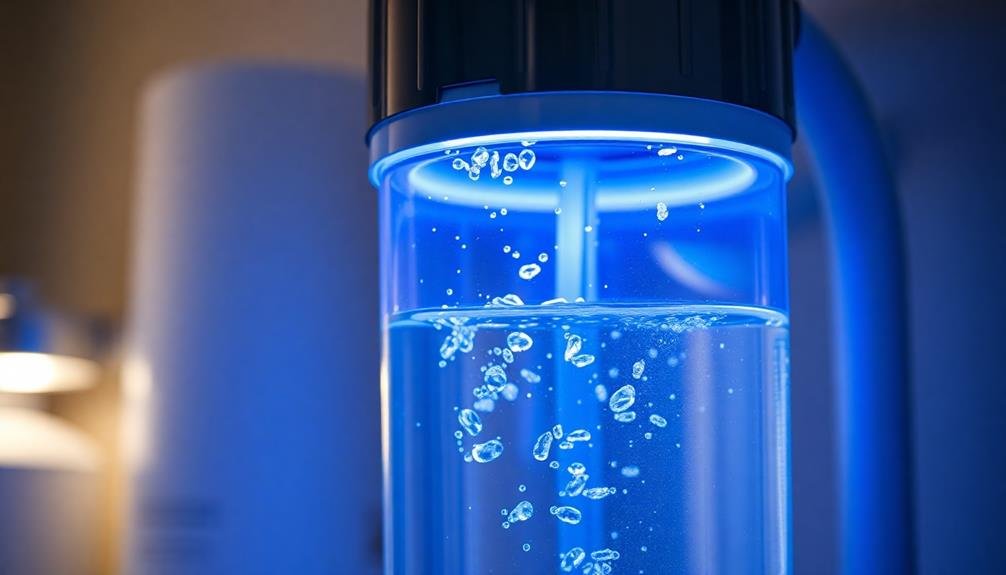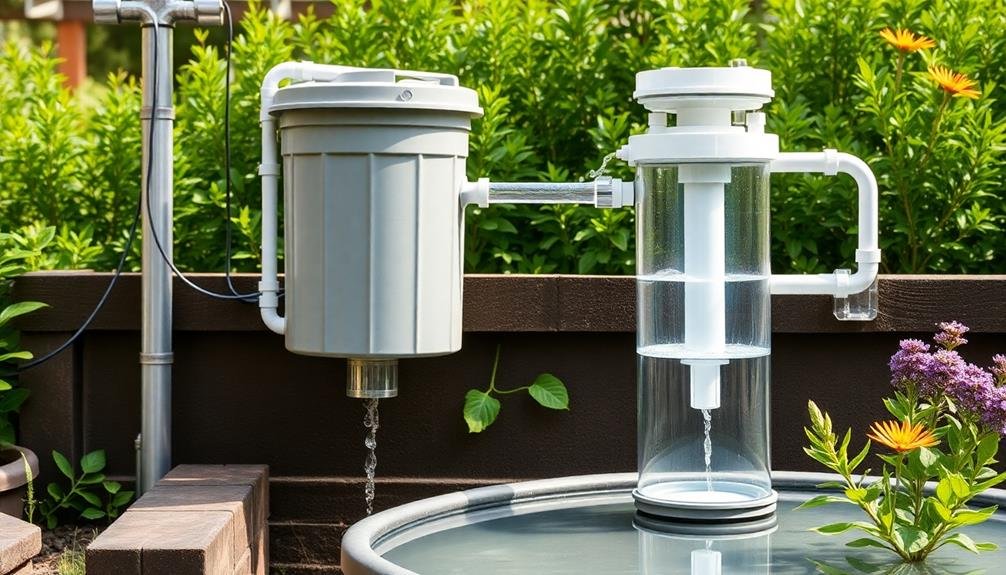The three best rainwater filtration components for home systems are first-flush diverters, sediment filters, and UV disinfection systems. First-flush diverters capture initial runoff containing contaminants, enhancing water quality entering storage tanks. Sediment filters remove particles like sand and silt, with cartridge and spin-down options available. UV disinfection systems serve as the final defense, inactivating microorganisms without chemicals. You'll need to take into account proper sizing for diverters, filter micron ratings, and UV system flow rates for peak performance. By incorporating these components, you'll greatly improve your rainwater quality and guarantee a safer, more sustainable water supply. Dive deeper to uncover the full potential of these filtration powerhouses.
First-Flush Diverters

Why is the first flush of rainwater so essential to divert? The initial runoff from your roof often contains the highest concentration of contaminants, including dust, debris, bird droppings, and pollutants. By diverting this first flush, you'll greatly enhance the quality of water entering your storage tank.
First-flush diverters are simple yet effective components of your rainwater harvesting system. They're typically installed at the downspout or before the main storage tank. As rain begins to fall, the diverter collects the initial flow of water, trapping contaminants in a separate chamber.
Once this chamber is full, cleaner water bypasses it and flows into your main storage.
You'll find various types of first-flush diverters on the market. Standpipe diverters use a vertical pipe that fills with the initial runoff. Float-ball systems employ a ball that rises with the water level, sealing off the diverter when full. Some advanced models include self-draining features or filters for added convenience.
When selecting a first-flush diverter, consider your roof size, local rainfall patterns, and ease of maintenance. Proper sizing is vital to guarantee effective contamination reduction without wasting too much water.
Sediment Filters
After the first-flush diverter does its job, sediment filters step in to further clean up your rainwater.
These filters remove particles like sand, silt, and debris that may have made it past the initial diversion. You'll typically find sediment filters in two main types: cartridge filters and spin-down filters.
Cartridge filters use replaceable elements made of materials like polypropylene or pleated polyester. They're available in various micron ratings, typically ranging from 1 to 50 microns. The lower the micron rating, the finer the particles the filter can capture.
You'll want to start with a higher micron filter and progressively move to finer filters for ideal results.
Spin-down filters, on the other hand, use centrifugal force to separate heavier particles from water. They're self-cleaning and require less maintenance than cartridge filters. However, they're not as effective at removing very fine particles.
When choosing sediment filters, consider factors like flow rate, filter life, and ease of maintenance.
It's often beneficial to use a combination of filter types to achieve the best results for your rainwater harvesting system.
UV Disinfection Systems

UV disinfection systems often serve as the ultimate line of defense in rainwater filtration setups. They use ultraviolet light to inactivate microorganisms, including bacteria, viruses, and protozoa, that may have slipped through earlier filtration stages.
These systems are highly effective, destroying up to 99.99% of harmful pathogens without adding chemicals to your water.
When choosing a UV system for your rainwater filtration, consider the flow rate you need. Most home systems range from 1 to 12 gallons per minute. Verify the UV lamp's power matches your water usage to provide adequate exposure time.
Look for models with a UV intensity monitor, which alerts you when the lamp's effectiveness diminishes.
You'll need to replace the UV lamp annually, even if it's still functioning, as its germicidal effectiveness decreases over time. Some advanced systems feature automatic lamp replacement reminders.
Install a pre-filter before your UV system to remove particles that can shield microorganisms from UV light.
Finally, consider models with a built-in flow restrictor to maintain proper exposure time and guarantee maximum disinfection efficiency.
With proper maintenance, a UV system will provide an additional layer of protection for your rainwater harvesting setup.
Frequently Asked Questions
How Much Maintenance Is Required for a Home Rainwater Filtration System?
You'll need to perform regular maintenance on your home rainwater filtration system. This includes cleaning filters, checking for leaks, and sanitizing tanks. Depending on your system's complexity, you might need to do this monthly or quarterly.
Can Rainwater Filtration Systems Be Installed in Apartments or Rental Properties?
You can install rainwater filtration systems in apartments or rentals, but you'll need your landlord's permission. Consider portable or temporary options that don't require permanent modifications. Balcony or window-mounted systems are ideal for small spaces.
What's the Average Cost of a Complete Home Rainwater Filtration Setup?
You'll find that a complete home rainwater filtration setup typically costs between $2,000 and $10,000. Your final price will depend on factors like system size, complexity, and quality of components you choose to install.
Are There Any Government Incentives for Installing Rainwater Filtration Systems?
You'll find that government incentives for rainwater filtration systems vary by location. Check with your local authorities for potential tax credits, rebates, or grants. Some areas offer financial support to encourage water conservation and sustainability practices.
How Does Water Pressure Compare Between Filtered Rainwater and Municipal Water Systems?
You'll typically find lower pressure in rainwater systems compared to municipal water. Your rainwater pressure depends on tank height and pump strength, while city water's consistently pressurized. You might need a booster pump for comparable pressure in your rainwater system.
In Summary
You've now learned about three essential components for effective rainwater filtration at home. By incorporating first-flush diverters, sediment filters, and UV disinfection systems, you'll greatly improve your water quality. Remember, these elements work together to remove debris, particles, and harmful microorganisms. Don't forget to maintain your system regularly for best performance. With these components in place, you're well on your way to enjoying clean, safe rainwater for various household uses.





Leave a Reply